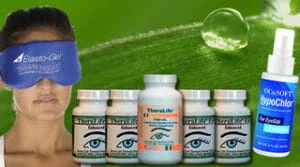TheraLife stands out as the sole provider of oral eye treatment care, offering a unique and effective approach to managing conditions like ocular rosacea. Their products are designed to enhance eye health from within, addressing the root causes rather than just symptoms. This internal treatment strategy helps manage various eye conditions, including blepharitis, dry eyes, and uveitis, by promoting natural healing processes and reducing inflammation.
TheraLife’s comprehensive range of products focuses on oral supplements that support eye health, utilizing natural ingredients to ensure safety and efficacy. These supplements are particularly beneficial for individuals with sensitive eyes, offering a gentle alternative to topical treatments that may cause irritation.
Moreover, TheraLife provides valuable resources on their website, guiding customers on how to effectively manage eye conditions at home. This includes information on dietary adjustments, natural remedies, and lifestyle changes that can complement their oral treatments.
By choosing TheraLife, customers gain access to a holistic eye care solution that is not available from any other company, making it a preferred choice for those seeking a natural, effective, and safe method to improve their ocular health. Always consult with an ophthalmologist to determine the suitability of these treatments for your specific condition.
Powerful Ocular Rosacea Relief With TheraLife
Chronic dry eye is a significant feature of ocular rosacea.
Treating dry eyes will reduce inflammation and keep ocular rosacea under control
Key Takeaways
- Rosehip oil, rich in essential fatty acids and vitamins, may support periorbital skin health and reduce inflammation when properly diluted.
- Calendula oil offers anti-inflammatory benefits but should only be used around the orbital bone with extreme caution and proper dilution.
- Pharmaceutical-grade tea tree oil, when highly diluted, may help manage Demodex mites, but must never contact the eye surface or lash line.
- Lavender oil has anti-inflammatory properties but lacks robust evidence for ocular rosacea and should only be used with careful dilution and patch testing.
- Always consult an ophthalmologist before using any essential oils near the eyes, as improper use can worsen ocular rosacea symptoms.
Understanding Ocular Rosacea and Its Symptoms
Although ocular rosacea primarily affects the eyes, it often manifests as chronic inflammation of the eyelids (blepharitis), conjunctival redness, and sensations of burning or grittiness.
As you navigate this condition, understanding ocular rosacea causes is essential. The pathogenesis involves dysregulation of the innate immune system, vascular instability, and increased Demodex folliculorum mite density.
These factors contribute to meibomian gland dysfunction, tear film instability, and persistent ocular surface irritation.
Symptom management requires a multifaceted approach, focusing on reducing inflammation, stabilizing the tear film, and controlling microbial load.
You’ll notice that flare-ups can be triggered by environmental factors like UV exposure, wind, or heat.
Incorporating warm compresses into your daily routine can significantly improve meibomian gland function and reduce inflammation, providing relief from ocular discomfort.
Accurate identification of symptoms and underlying triggers enables you to adopt targeted interventions, optimizing long-term ocular surface health.
Criteria for Choosing Eye-Safe Essential Oils
When selecting essential oils for ocular rosacea, you should prioritize pharmaceutical-grade purity, validated dilution protocols, and absence of known ocular irritants. It’s critical to choose formulations with established safety profiles and those endorsed by ophthalmologists. This approach minimizes adverse reactions and optimizes therapeutic outcomes. Additionally, incorporating Omega 3 fatty acids into your routine can significantly reduce ocular surface inflammation, which is a common aspect of managing ocular rosacea.
Purity and Dilution Standards
Stringent purity and dilution standards form the foundation for safely selecting essential oils for ocular rosacea management. You must prioritize oils obtained through reputable essential oil extraction methods, such as steam distillation or cold pressing, which minimize contaminants and preserve therapeutic compounds.
Always verify that the essential oil is 100% pure, free from additives, synthetic fragrances, or adulterants, as impurities can provoke ocular irritation. For application near sensitive periocular skin, adhere to evidence-based dilution protocols.
Combine the essential oil with a high-quality carrier oil—such as fractionated coconut, jojoba, or sweet almond—at concentrations typically not exceeding 0.5–1%. These carrier oil recommendations help mitigate potential sensitization and reduce volatility.
Rigorous attention to purity and proper dilution directly supports ocular safety and therapeutic efficacy. TheraLife Omega-3 is an example of a product that follows strict purity standards, ensuring the removal of contaminants like mercury and lead.
Non-Irritating Oil Properties
To minimize the risk of periocular irritation in ocular rosacea, select essential oils characterized by low allergenic potential, minimal volatility, and documented anti-inflammatory properties. When you prioritize non irritating oil benefits, you’re reducing the likelihood of hypersensitivity reactions, stinging, or exacerbation of periorbital erythema. Essential oil safety hinges on avoiding compounds known for high irritancy, such as phenols and aldehydes, and instead opting for oils rich in terpenes or esters, which typically demonstrate better ocular compatibility. Additionally, lower volatility decreases the risk of airborne oil molecules coming into contact with sensitive ocular tissues. Always verify clinical data supporting the anti-inflammatory and soothing effects of chosen oils, as evidence-based selection underpins safety and efficacy for individuals managing ocular rosacea. It’s important to consider omega-3 supplements as they support tear film health and reduce inflammation, which can have a synergistic effect when used alongside essential oils.
Ophthalmologist-Recommended Formulations
Although essential oils have gained popularity for adjunctive skin care, ophthalmologists emphasize stringent criteria for ocular use, particularly in the context of ocular rosacea.
When considering essential oil benefits for ocular health, you must prioritize formulations that minimize risk while maximizing therapeutic outcomes. Evidence-based guidelines focus on safety, purity, and clinical efficacy to prevent exacerbation of ocular surface inflammation.
Ophthalmologist-recommended formulations adhere to these criteria:
- Pharmaceutical-Grade Purity: Select oils free from contaminants, synthetic additives, and allergens to protect the delicate ocular surface.
- Appropriate Dilution: Guarantee essential oils are diluted to concentrations proven safe for periocular or eyelid application, reducing cytotoxicity and irritation risk.
- Non-Irritant, Hypoallergenic Carriers: Use carrier oils with established ocular tolerability, such as fractionated coconut or mineral oil, supporting barrier function.
Chronic dry eyes can exacerbate conditions like ocular rosacea, so it’s crucial to choose treatments that are gentle and supportive for sensitive areas.
These measures optimize essential oil benefits without compromising ocular health.
Chamomile Oil: Calming Properties for Sensitive Eyes
Chamomile oil, often praised for its anti-inflammatory and soothing effects on skin, lacks substantiated evidence supporting its safety or efficacy for ocular application, particularly in individuals with ocular rosacea.
While chamomile benefits are well-documented for dermatological use—primarily through its bioactive compounds such as bisabolol and chamazulene—these properties don’t necessarily translate to ophthalmic safety or therapeutic value.
If you experience eye sensitivity due to ocular rosacea, it’s essential to recognize that direct or even periocular exposure to essential oils, including chamomile, may provoke irritation, allergic reactions, or exacerbate underlying inflammation.
Current clinical guidelines don’t recommend chamomile oil for managing ocular surface disease. Instead, consult your ophthalmologist before considering any topical alternative, as inappropriate use could compromise your ocular surface integrity and overall eye health.
Understanding dry eye is crucial, as it is a multifactorial condition where an imbalance in tear production might contribute to symptoms similar to those experienced in ocular rosacea.
Lavender Oil: Reducing Inflammation Gently
You can benefit from lavender oil’s anti-inflammatory and soothing properties when managing ocular rosacea symptoms. It’s crucial to use precise dilution techniques to minimize irritation and maximize safety near the delicate periocular area. Clinical studies indicate that low concentrations in appropriate carriers reduce inflammation without compromising ocular surface integrity. Topical cyclosporine A is also used for ocular surface diseases and shows promise for treating ocular rosacea.
Soothing Properties for Eyes
While lavender oil is reputed for its anti-inflammatory properties in dermatological applications, current evidence doesn’t support its direct use for reducing inflammation in ocular tissues affected by rosacea.
You may be seeking natural solutions for symptoms such as eye strain or ocular discomfort; however, clinical literature doesn’t validate lavender oil as a safe or effective topical intervention for these concerns.
Prioritizing evidence-based strategies is imperative when addressing ocular surface inflammation.
Consider the following:
- Implement lifestyle adjustments—such as optimizing screen time and improving ambient lighting—to minimize eye strain.
- Use ophthalmologist-recommended artificial tears or lubricants to support ocular surface integrity.
- Consult with an eye care professional before introducing any essential oils near the periocular region.
Adhering to these evidence-driven practices protects your eyes from unsubstantiated remedies.
For those experiencing posterior blepharitis, incorporating treatments that target gland dysfunction can be beneficial in managing dry eye symptoms.
Safe Dilution Techniques
Despite widespread claims about the gentle anti-inflammatory potential of diluted lavender oil, no robust clinical evidence supports its safe application for ocular rosacea or periocular inflammation.
When considering any essential oil near the ocular area, you must prioritize safe blending practices and understand the risks. Use only pharmaceutical-grade carrier oils for dilution, maintaining concentrations below 0.5% to minimize irritation risk. Conduct a patch test on non-ocular skin prior to any periocular use, although even this can’t guarantee ocular safety.
Always verify essential oil storage in airtight, UV-protected containers to maintain chemical stability and prevent degradation, which could elevate irritant potential. Contaminated eye makeup can exacerbate symptoms of ocular rosacea, similar to blepharitis, so maintaining hygiene is crucial.
Ultimately, you should consult an ophthalmologist before attempting any topical essential oil application for ocular rosacea, as evidence-based protocols for lavender oil are lacking.
Tea Tree Oil: Antimicrobial Support With Caution
Although tea tree oil demonstrates broad-spectrum antimicrobial properties, its application near the eyes warrants substantial caution in the context of ocular rosacea. The essential properties of tea tree—namely terpinen-4-ol—exhibit efficacy against Demodex mites, which are linked to ocular surface inflammation.
However, the oil’s irritant potential is significant, even at low concentrations. Direct exposure to the periocular area can cause stinging, redness, and further compromise the ocular surface barrier.
Consider these clinical precautions:
- Dilution is crucial: Never use undiluted tea tree oil; always combine with a suitable carrier oil.
- Avoid direct ocular contact: Carefully apply to eyelid margins only, steering clear of the conjunctival sac.
- Monitor for adverse reactions: Discontinue use immediately if you notice increased irritation or sensitivity.
Tea tree oil should be used with proper technique to ensure safety while leveraging its essential properties.
Rosehip Oil: Nourishing the Delicate Eye Area
You can incorporate rosehip oil to provide the periocular skin with vitamins A, C, and essential fatty acids that support barrier function.
Its lightweight emollient properties offer gentle hydration without exacerbating ocular surface irritation.
Clinical studies indicate rosehip oil may help reduce erythema, supporting a more even skin tone in ocular rosacea.
Nutrient-Rich Skin Support
When considering nutrient-rich options for supporting the delicate skin around the eyes, rosehip oil often emerges due to its concentration of essential fatty acids, vitamins A and C, and antioxidant compounds.
You’ll find that these bioactive constituents facilitate ideal nutrient absorption and provide a foundation for skin hydration. Clinical studies suggest that applying rosehip oil can enhance the skin barrier, reduce oxidative stress, and support cellular regeneration within the periorbital area.
By incorporating rosehip oil into your regimen, you target the underlying pathophysiology of ocular rosacea-related skin concerns.
Consider these clinical benefits of rosehip oil:
- Promotes effective nutrient absorption for improved skin resilience.
- Delivers antioxidants that protect against environmental stressors.
- Supports skin hydration and natural repair processes, fostering healthier periorbital skin.
Gentle Hydration Benefits
Building on rosehip oil’s nutrient-dense profile, its gentle hydrating properties provide targeted support for the sensitive periorbital region affected by ocular rosacea. You’ll find that rosehip oil delivers essential fatty acids and antioxidants, reinforcing the skin’s barrier function while minimizing trans-epidermal water loss. This gentle hydration is critical for maintaining ocular comfort without provoking irritation or exacerbating sensitivity.
| Benefit | Mechanism | Clinical Impact |
|---|---|---|
| Moisture Retention | Omega-3 & 6 fatty acids | Reduces dryness |
| Barrier Reinforcement | Antioxidant activity | Prevents irritation |
| Lightweight Absorption | Non-comedogenic, fast-absorbing | No pore clogging |
| Sensitivity Reduction | Anti-inflammatory constituents | Supports comfort |
You should apply rosehip oil sparingly, ensuring ideal hydration without overwhelming the delicate ocular environment, thereby supporting ongoing comfort and skin resilience.
Reducing Redness Naturally
Although ocular rosacea often presents with persistent redness and irritation around the eyes, rosehip oil‘s high concentration of linoleic acid and naturally occurring antioxidants modulate inflammatory pathways and promote tissue repair.
If you’re considering natural remedies or holistic approaches, rosehip oil offers a targeted solution for reducing visible erythema in the periorbital region. Its bioactive components support cellular regeneration and stabilize the delicate ocular skin barrier.
When applied with proper dilution, rosehip oil minimizes irritation and enhances comfort in sensitive individuals. To optimize outcomes, integrate rosehip oil as part of a thorough ocular rosacea protocol, ensuring compatibility with your current regimen.
Here’s how rosehip oil supports redness reduction:
- Modulates pro-inflammatory cytokine activity
- Enhances microvascular stability
- Supports antioxidant-mediated tissue healing
Calendula Oil: Soothing Irritation and Redness
Despite its historical use in dermatology for its purported anti-inflammatory properties, calendula oil lacks robust clinical evidence supporting its safety or efficacy for ocular rosacea. If you’re considering calendula benefits for soothing irritation and redness, it’s essential to note that most data is anecdotal. Topical application near the eye area carries risk, as ocular tissues are sensitive to potential irritants and allergens. Always consult an ophthalmologist before introducing any new agent.
Here’s a brief overview:
| Property | Evidence Level | Clinical Recommendation |
|---|---|---|
| Anti-inflammatory | Limited, anecdotal | Not established for ocular use |
| Redness reduction | Unproven | Caution advised |
| Safety (ocular) | Unclear | Avoid direct contact |
| Topical use | Dermatology only | Not eye-specific |
| Allergen risk | Potential | Patch test recommended |
You shouldn’t substitute calendula for proven ophthalmic therapies.
Frankincense Oil: Promoting Skin Barrier Health
While frankincense oil contains compounds with reported anti-inflammatory and skin barrier-supporting effects, no peer-reviewed clinical trials validate its safety or efficacy for ocular rosacea.
You may encounter claims regarding frankincense benefits for enhancing skin hydration and reducing inflammation, but these are based primarily on laboratory or anecdotal evidence.
Mechanistically, boswellic acids in frankincense oil are thought to inhibit pro-inflammatory mediators and support epidermal barrier function.
However, the periocular region is highly sensitive, and improper use may risk irritation or sensitization.
Consider these key points:
- Frankincense benefits for skin hydration and barrier support remain unproven in ocular rosacea.
- The periocular area is susceptible to irritation from essential oils.
- Evidence supporting frankincense oil’s efficacy and safety for ocular applications is currently lacking.
Always consult your ophthalmologist before considering any topical intervention.
Safe Application Methods for Essential Oils Around the Eyes
Because the periocular skin exhibits heightened sensitivity, you must exercise extreme caution when considering essential oil use near the eyes.
Begin by selecting only eye-safe essential oil blends, ensuring they’re free from known irritants and appropriately diluted (generally 0.5–1% in a neutral carrier oil such as squalane or fractionated coconut oil).
Integrate these blends into your eye care routines by applying them exclusively to the orbital bone, never directly on the eyelid margin or lash line, to mitigate the risk of migration into the ocular surface.
Employ a sterile cotton swab or clean fingertip for precise application, using gentle, patting motions.
Always perform a patch test on the inner forearm prior to periocular use to evaluate for hypersensitivity and minimize adverse reactions.
Precautions and Potential Side Effects to Consider
Although essential oils offer potential adjunctive benefits in managing ocular rosacea symptoms, you must recognize the inherent risks associated with their use near the eyes.
Even eye-safe essential oils can cause irritation, allergic reactions, or exacerbate inflammation if not used with stringent precautions. Key essential oil precautions revolve around dilution, application technique, and product selection to uphold eye safety.
Evidence indicates that improper use may disrupt the tear film or damage the sensitive periocular tissues.
Consider these critical precautions and potential side effects:
- Corneal Irritation: Direct or accidental contact can result in burning, redness, or vision disturbances.
- Allergic Contact Dermatitis: Sensitization may lead to periorbital swelling, pruritus, or erythema.
- Exacerbation of Ocular Rosacea: Some essential oils may aggravate preexisting inflammation or dryness.
Always consult your ophthalmologist before use.
Powerful Ocular Rosacea Relief With TheraLife
Chronic dry eye is a significant feature of ocular rosacea.
Treating dry eyes will reduce inflammation and keep ocular rosacea under control
Frequently Asked Questions
Can Essential Oils Interact With Prescription Medications for Ocular Rosacea?
You should exercise caution when using essential oils with ocular rosacea medications, as essential oils interactions may alter drug absorption, metabolism, or efficacy.
Compounds in essential oils can induce or inhibit cytochrome P450 enzymes, potentially impacting pharmacokinetics of prescribed therapies.
Although data is limited, avoid topical or periocular application without ophthalmologist consultation, as adverse reactions or reduced therapeutic effects could occur.
Always disclose any essential oil usage to your healthcare provider for best management.
Are There Any Dietary Changes That Support Essential Oil Treatments for Eye Health?
You can enhance essential oil treatments for eye health by adopting dietary changes rich in dietary antioxidants and omega fatty acids.
Antioxidants like vitamins C and E neutralize oxidative stress in ocular tissues, while omega-3 and omega-6 fatty acids modulate inflammatory pathways and support tear film stability.
Integrating foods such as leafy greens, berries, flaxseeds, and fatty fish into your diet may synergistically improve ocular surface health and optimize therapeutic outcomes.
How Should Essential Oils Be Stored to Maintain Their Potency and Safety?
To maintain potency and safety, you should practice proper storage for essential oils.
Always keep them in dark, airtight essential oil containers made of glass, preferably amber or cobalt blue, to minimize photodegradation and oxidation.
Store containers in a cool, dry environment away from direct sunlight and fluctuating temperatures.
Guarantee the caps are tightly sealed to prevent volatile compound evaporation, and label each bottle with the date of opening to monitor shelf life and chemical stability.
Is It Safe to Use Essential Oils With Contact Lenses?
Think of your eyes as delicate camera lenses—introducing essential oils is like pouring water on the lens: it clouds and damages.
Regarding essential oils safety and contact lens compatibility, it’s not safe to use essential oils with contact lenses. These oils can adhere to the lens surface, causing irritation, chemical burns, or even corneal damage.
Always avoid direct contact between essential oils and contact lenses to protect ocular health and maintain visual clarity.
Can Children or Pregnant Women Use These Essential Oils for Ocular Rosacea?
You should exercise caution regarding essential oils safety in children and pregnancy, especially for ocular application.
Pediatric and obstetric populations have increased susceptibility to adverse reactions and systemic absorption. Clinical evidence regarding essential oils’ ocular safety is limited, particularly in these groups.
You shouldn’t apply any essential oils near the eyes of children or pregnant women without explicit guidance from a healthcare professional, as risks may outweigh potential benefits in these sensitive populations.
Powerful Ocular Rosacea Relief With TheraLife
Chronic dry eye is a significant feature of ocular rosacea.
Treating dry eyes will reduce inflammation and keep ocular rosacea under control
Conclusion
When it comes to managing ocular rosacea, TheraLife offers a unique approach by providing the only oral eye treatment care available. Their products are designed to support eye health from within, addressing the root causes of various eye conditions rather than just symptoms. This approach is beneficial for customers who struggle with conditions like dry eyes, blepharitis, and ocular rosacea.
TheraLife’s products are formulated with natural ingredients that are carefully selected to ensure safety and efficacy. They work by enhancing the body’s natural ability to produce and maintain tear flow, which is crucial for eye health. This is particularly beneficial for individuals living in environments that exacerbate dry eye conditions, as TheraLife’s oral treatment offers a comprehensive solution that topical treatments alone cannot provide.
Moreover, TheraLife emphasizes the importance of evidence-based practices, ensuring their products are backed by research and professional consultation. Customers are encouraged to consult their ophthalmologists before using new treatments, ensuring optimal safety and effectiveness.
In addition to their innovative products, TheraLife offers extensive resources and guidance on managing various eye conditions, from blepharitis and uveitis to challenges like Sjogren’s syndrome and eyelash mites. Their holistic approach includes dietary recommendations and lifestyle changes that complement their treatment products.
Overall, TheraLife stands out by offering an oral eye treatment that is unique in the market, supporting customers in achieving long-term eye health and comfort.





